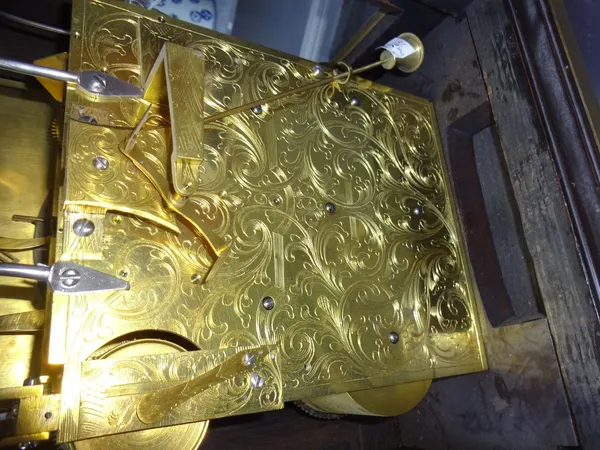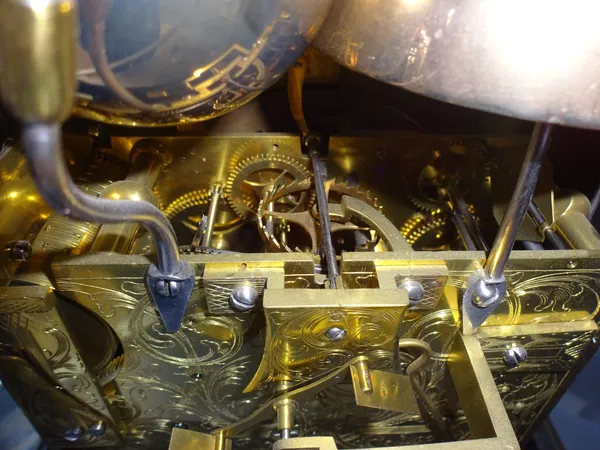A FINE AND RARE GEORGE III ORMOLU-MOUNTED EBONISED PEARWOOD MUSICAL QUARTER CHIMING, REPEATING AND STRIKING AUTOMATON BRACKET CLOCK
By Stephen Rimbault, London, circa 1763
| Estimate: | £10,000 - £15,000 |
| Hammer price: | £15,000 |
The bell top case with brass carrying handle and four cone finials, above glazed door, flanked by a female caryatid to each corner, the sides each with two glazed panels, on a stepped base and brass bracket feet, the arched 6 ¾ in. dial with three automaton figures at the top on a painted ground depicting farriers at work, a furnace at the side, above silvered chapter ring and pierced brass spandrels, enclosing a matted centre with signature plate recess and calendar aperture above the VI, with tune selector at III o’clock, the substantial three train chain fusée movement chiming the quarters on a carillon of eight bells with fifteen hammers and striking the hours on a single bell, with two pull repeats, one for the hour, the other for the quarters and hour, verge escapement and foliate engraved backplate
48 cm high
John Stephen Rimbault is recorded as working at Great St. Andrew's Street, St. Giles, London from 1744-1785. Of Huguenot descent, he specialised in musical and automaton clocks.
The painted scene on this clock may be attributable to the artist Johann Zoffany (1733-1810). Zoffany was living in the garret of a house in Short's Gardens, Drury Lane. Finding it hard to find work, perhaps in part because of his poor English, he was introduced to Rimbault by an Italian musical-box maker named Bellodi, who worked for the clockmaker, pricking the barrels for the musical clocks. Rimbault employed Zoffany as a decorative assistant to paint dials and automaton figures.
Subsequently, Rimbault introduced Zoffany to the portrait painter Benjamin Wilson, who employed him at £40 to fill his draperies. His talent was soon recognised by David Garrick, for whom he painted pictures of actors on stage. By 1764 Zoffany was enjoying the patronage of George III. A few years later Zoffany was a founding member of the Royal Academy.
Rimbault's portrait is held at The Tate, London. Painted by Johann Zoffany (1733-1810) around 1764, it is exceptional and its creation is significant and no doubt painted as a homage in gratitude to Rimbault. It remained in the family until the 20th Century. (https://www.tate.org.uk/art/artworks/zoffany-stephen-rimbault-n04434)
Another virtually identical clock with automaton was sold Christie's, London, 13 November 2014, lot 140 (£16,250). Another musical clock by Rimbault was sold Christie's, Amsterdam, The P. C. Spanns Collection, 19 December 2007, lot 466 (E48,000).
COMPARATIVE LITERATURE:
Arthur W. J. G. Ord-Hume, The Musical Clock, Asbourne 1995.
Richard Barder, The Georgian Bracket Clock 1714-1830, Woodbridge, 1993, p.60, pl. II/43.
Condition Report:
1 winding key. 2 case keys.
The clock is in good condition. There is a repairer’s label dated 8/03 on the inside of the back door, so possibly this tells us when it was last overhauled.
The clock is working and ticking. Please note the tune selector at the three o’clock. It has two tunes for the quarters. The carillon bell stand has a repair with a brass joint. There are eight bells. The linkage for one automaton figure needs attention (far left).
The case was most likely ebonised originally.
Some marks and chips to veneer consistent with age.


















